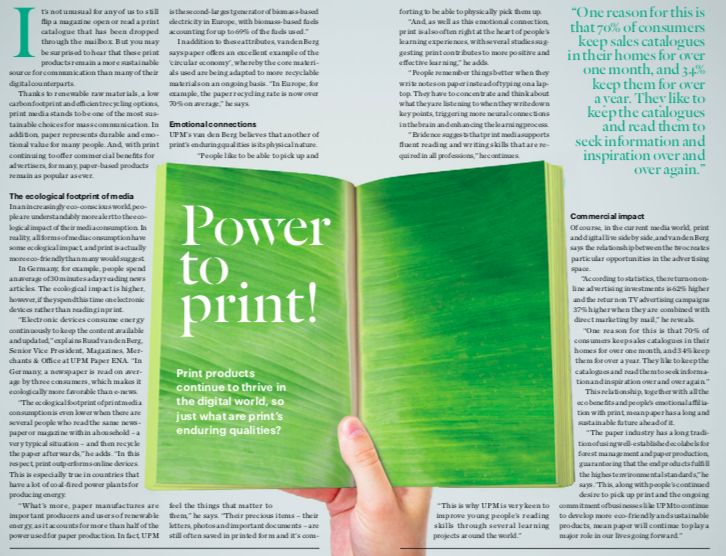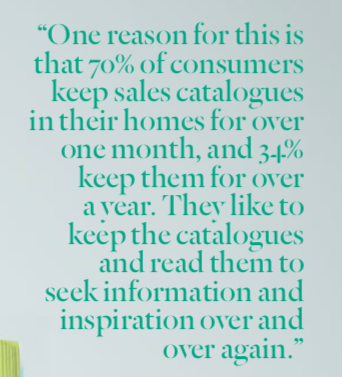
10 Dec Power to print!
Print products continue to thrive in the digital world, so just what are print’s enduring qualities?
It’s not unusual for any of us to still flip a magazine open or read a print catalogue that has been dropped through the mailbox. But you may be surprised to hear that these print products remain a more sustainable
source for communication than many of their digital counterparts.
Thanks to renewable raw materials, a low carbon footprint and efficient recycling options, print media stands to be one of the most sustainable choices for mass communication. In addition, paper represents durable and emotional value for many people. And, with print continuing to offer commercial benefits for advertisers, for many, paper-based products remain as popular as ever.
The ecological footprint of media
In an increasingly eco-conscious world, people are understandably more alert to the ecological impact of their media consumption. In reality, all forms of media consumption have some ecological impact, and print is actually more eco-friendly than many would suggest.
In Germany, for example, people spend an average of 30 minutes a day reading news articles. The ecological impact is higher, however, if they spend this time on electronic devices rather than reading in print.
“Electronic devices consume energy continuously to keep the content available and updated,” explains Ruud van den Berg, Senior Vice President, Magazines, Merchants & Office at UPM Paper ENA. “In Germany, a newspaper is read on aver- age by three consumers, which makes it ecologically more favorable than e-news.

“The ecological footprint of print media consumption is even lower when there are several people who read the same news- paper or magazine within a household – a very typical situation – and then recycle the paper afterwards,” he adds. “In this respect, print outperforms online devices. This is especially true in countries that have a lot of coal-fired power plants for producing energy.
“What’s more, paper manufactures are important producers and users of renewable energy, as it accounts for more than half of the power used for paper production. In fact, UPM is the second-largest generator of biomass-based electricity in Europe, with biomass-based fuels accounting for up to 69% of the fuels used.”
In addition to these attributes, van den Berg says paper offers an excellent example of the ‘circular economy’, whereby the core materials used are being adapted to more recyclable materials on an ongoing basis. “In Europe, for example, the paper recycling rate is now over 70% on average,” he says.
Emotional connections
UPM’s van den Berg believes that another of print’s enduring qualities is its physical nature. “People like to be able to pick up and feel the things that matter to
them,” he says. “Their precious items – their letters, photos and important documents – are still often saved in printed form and it’s comforting to be able to physically pick them up. “And, as well as this emotional connection, print is also often right at the heart of people’s learning experiences, with several studies sug- gesting print contributes to more positive and effective learning,” he adds.
“People remember things better when they write notes on paper instead of typing on a laptop. They have to concentrate and think about what they are listening to when they write down key points, triggering more neural connections in the brain and enhancing the learning process.
“Evidence suggests that print media supports fluent reading and writing skills that are required in all professions,” he continues.
“This is why UPM is very keen to improve young people’s reading skills through several learning projects around the world.
Commercial impact
Of course, in the current media world, print and digital live side by side, and van den Berg says the relationship between the two creates particular opportunities in the advertising space.
“According to statistics, the return on online advertising investments is 62% higher and the return on TV advertising campaigns 37% higher when they are combined with direct marketing by mail,” he reveals.
“One reason for this is that 70% of consumers keep sales catalogues in their homes for over one month, and 34% keep them for over a year. They like to keep the catalogues and read them to seek information and inspiration over and over again.” This relationship, together with all the eco benefits and people’s emotional affiliation with print, mean paper has a long and sustainable future ahead of it.
“The paper industry has a long tradition of using well-established ecolabels for forest management and paper production, guaranteeing that the end products fulfill the highest environmental standards,” he says. ‘This, along with people’s continued desire to pick up print and the ongoing commitment of businesses like UPM to continue to develop more eco-friendly and sustainable products, mean paper will continue to play a major role in our lives going forward.”


